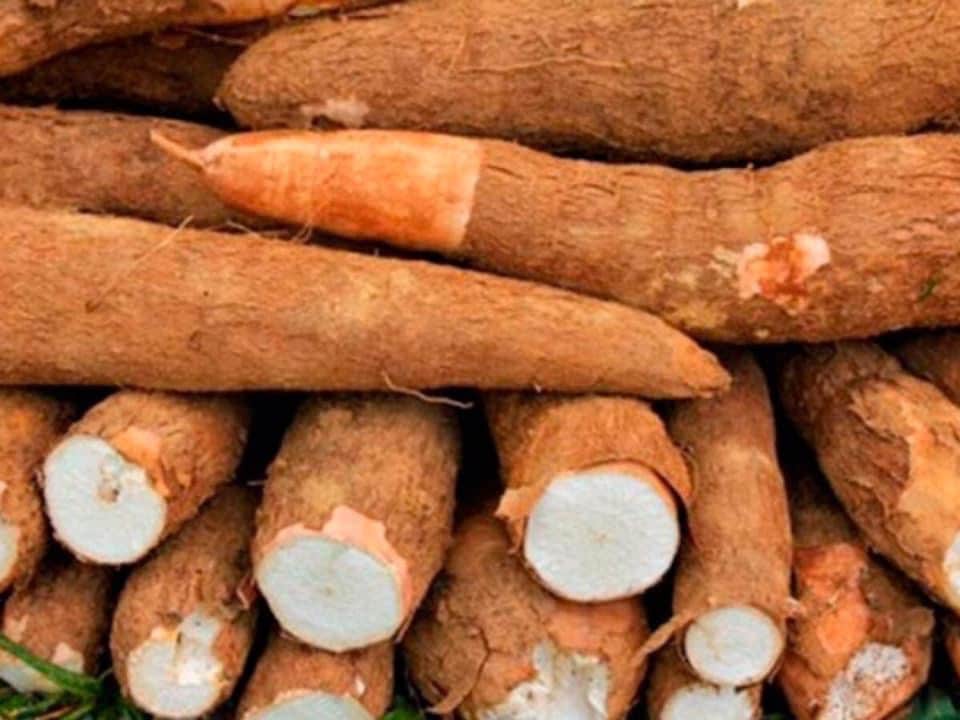Cassava:
What is it?, history, cultivation, nutritional value, uses, recipes, and more...
Cassava is an edible root tuber originating from South America and is primarily cultivated in tropical countries across the Americas, Asia, and Africa. It is considered one of the major sources of carbohydrates in many parts of the world due to its nutritional properties similar to potatoes.
Índice
What is Cassava?
Cassava, also known as yuca or manioc, is a perennial shrub belonging to the Euphorbiaceae family, native to Central South America. It is cultivated in tropical regions around the world and is considered the primary source of carbohydrates for over eight hundred million people globally (Lebot, 2009; FAO, 2013; Clement, 2016).
Cassava is a shrub that can reach up to three meters in height, with an elongated, cylindrical, and oblong root that can measure up to a meter in length and 10 cm in diameter. Its skin is woody, tough, and inedible, protecting the pulp from oxidation. The pulp is firm before cooking, traversed by rigid longitudinal fibers, and can be white or yellowish in color depending on the variety.
This tuber is known for its high content of carbohydrates and sugars, and it oxidizes rapidly once the protective skin is removed.
History of Cassava
The earliest evidence of cassava cultivation dates back 4,000 years, making it one of the first crops to be domesticated in the Americas. Around 1,400 years ago, the Maya civilization utilized this tuber to nourish their numerous populations, particularly during the classic period, and especially in the southern region of Mesoamerica where significant cities were located (Tikal, Copán, Calakmul).
By the time the Spanish arrived, cassava had already become a staple food for native populations in northern South America, southern Central America, and the Caribbean islands. It was the Portuguese and Spanish who further expanded and continued its cultivation to Africa, Asia, and the Indies, including the Philippines and Taiwan.
In Africa, for instance, cassava is not only a coveted source of energy and nutrients for the population but also provides economic livelihoods for over 300 million people.
Furthermore, the scientific name of cassava was originally given by Crantz in 1766. Subsequently, the tuber was reclassified by Pohl in 1827 and Pax in 1910 into two different species: bitter cassava (Manihot utilissima) and sweet cassava (M. aipi). However, priority has been given to Crantz’s work, and his proposed name continues to be used today.

Common name of Cassava
| Northern South America, Central America, and the Caribbean | Yuca |
| Argentina, Brazil, and Paraguay | Mandioca |
| English-speaking countries | Cassava, aipi |
| Brazil | Macacheira |
| Mexico | Guacamote, guacamota |
| Countries of East Africa (Swahili): | Mhogo |
Scientific name of Cassava
Manihot esculenta
Taxonomy of Cassava
| Reino | Plantae |
| División | Magnoliophyta |
| Clase | Magnoliopsida |
| Orden | Malpighiales |
| Familia | Euphorbiaceae |
| Subfamilia | Crotonoideae |
| Tribu | Manihoteae |
| Género | Manihot |
| Especie | Manihot esculenta |
Synonymy of Cassava
Janipha aipi (Pohl) J.Presl
Janipha manihot (L.) Kunth
Jatropha aipi (Pohl) A.Moller
Jatropha diffusa (Pohl) Steud.
Jatropha digitiformis (Pohl) Steud.
Jatropha dulcis J.F.Gmel.
Jatropha flabellifolia (Pohl) Steud.
Jatropha glauca A.Rich.
Jatropha janipha Lour.
Jatropha loureiroi (Pohl) Steud.
Jatropha manihot L.
Jatropha mitis Rottb.
Jatropha mitis Sessé & Moç.
Jatropha paniculata Ruiz & Pav. ex Pax
Jatropha silvestris Vell.
Jatropha stipulata Vell.
Mandioca aipi (Pohl) Link
Mandioca dulcis (J.F.Gmel.) D.Parodi
Mandioca utilissima (Pohl) Link
Manihot aipi Pohl
Manihot aipi var. lanceolata Pohl
Manihot aipi var. latifolia Pohl
Manihot aipi var. lutescens Pohl
Manihot aypi Spruce
Manihot cannabina Sweet
Manihot cassava Cook & Collins
Manihot diffusa Pohl
Manihot digitiformis Pohl
Manihot dulcis (J.F.Gmel.) Baill.
Manihot dulcis var. aipi (Pohl) Pax
Manihot dulcis var. diffusa (Pohl) Pax
Manihot dulcis var. flabellifolia (Pohl) Pax
Manihot edule A.Rich.
Manihot esculenta subsp. alboerecta Cif.
Manihot esculenta var. argentea Cif.
Manihot esculenta var. coalescens Cif.
Manihot esculenta var. communis Cif.
Manihot esculenta var. debilis Cif.
Manihot esculenta subsp. diffusa Cif.
Manihot esculenta var. digitifolia Cif.
Manihot esculenta var. domingensis Cif.
Manihot esculenta var. fertilis Cif.
Manihot esculenta subsp. flabellifolia (Pohl) Cif.
Manihot esculenta var. flavicaulis Cif.
Manihot esculenta var. fuscescens Cif.
Manihot esculenta subsp. grandifolia Cif.
Manihot esculenta var. hispaniolensis Cif.
Manihot esculenta var. jamaicensis Cif.
Manihot esculenta var. luteola Cif.
Manihot esculenta var. mutabilis Cif.
Manihot esculenta var. nodosa Cif.
Manihot esculenta var. pohlii Cif.
Manihot esculenta var. ramosissima Cif.
Manihot esculenta var. rufescens Cif.
Manihot esculenta var. sprucei Lanj.
Manihot esculenta var. zimmermannii Cif.
Manihot flabellifolia Pohl
Manihot flexuosa Pax & K.Hoffm.
Manihot guyanensis Klotzsch ex Pax
Manihot loureiroi Pohl
Manihot (L.) H.Karst.
Manihot melanobasis Müll.Arg.
Manihot palmata var. aipi (Pohl) Müll.Arg.
Manihot palmata var. diffusa (Pohl) Müll.Arg.
Manihot palmata var. digitiformis (Pohl) Müll.Arg.
Manihot palmata var. flabellifolia (Pohl) Müll.Arg.
Manihot sprucei Pax
Manihot utilissima Pohl
Manihot utilissima var. castellana Pohl
Manihot utilissima var. sutinga Pohl
Etymology of Cassava
La palabra yuca deriva del maya jook’ka que significa “desenterrar una raíz para el metate”. Metate es un término que designa una especie de mortero o molino de piedra de la cocina autóctona mesoamericana.
Habitat of Cassava
- Habitat
Habitat of Cassava
The cassava plant grows in a variety of tropical conditions: in warm and humid lowland tropics; in mid-altitude tropics; and in sub-tropics with cold winters and summer rains. While cassava thrives in fertile soils, it has the comparative advantage of being able to grow in acidic, low-fertility soils with sporadic rainfall or long periods of drought, which enhances its profitability.
However, it should be noted that it does not tolerate waterlogging or saline soil conditions. It also cannot withstand frost and requires high levels of humidity and sunlight to grow.
It is a highly adaptable crop that can be grown from sea level up to 1,800 meters above sea level, at temperatures between 20 and 30°C with an optimal temperature of 24°C, a relative humidity between 50 and 90 percent with an optimal humidity of 72 percent, and an annual precipitation between 600 and 3,000 mm with an optimal precipitation of 1,500 mm.
Its growth cycle depends on environmental conditions: it is shorter, 7 to 12 months, in warmer areas and longer, 12 months or more, in regions at altitudes of 1,300 to 1,800 meters above sea level. Its production occurs in the following stages:
Rooting of the stakes
Tuberization
Radical thickening
Accumulation
In the currently cultivated varieties, cassava is better reproduced through cuttings rather than seeds. Usually, the plant is uprooted at the age of one year to extract the edible roots. If it exceeds this age, the root becomes hardened to the point of inedibility. Cuttings for replanting are taken from uprooted plants.
Geographic Distribution of Cassava

Cajamarca, Amazonas, Loreto, San Martín, Ucayali
Seasonal Availability of Cassava
- Year-round
Varieties of Cassava
The International Center for Tropical Agriculture (CIAT) maintains the world’s largest collection of cassava in vitro germplasm bank, with 6,073 discriminated clones of Manihot esculenta, including primitive cultivars, improved cultivars, and genetic material, and 349 corresponding accessions.
In common use, farmers name varieties with simple names that relate to some characteristic of the plant or its origin. However, this use of common names can lead to confusion, as the same name can be attributed to different or contrasting genotypes in different places or even the same place.
Two types of cassava are typically considered, which have differences but are used similarly:
-
Sweet Cassava
-
Bitter Cassava
Nutritional Value of Cassava
Cassava roots are a source of carbohydrates and calories, while the leaves contain proteins, minerals, and vitamins. Additionally, cassava is high in resistant starch, a type of carbohydrate that is not digested as it passes through the small intestine and promotes bacterial flora.
This food provides a high percentage of energy to the body and is recommended in weight loss diets due to its low fat content and easy digestion.
The main compounds found in cassava are:
- 9 amino acids Vitamins: pro-vitamin A, B1, B2, B3, B5, B6, C, E, K
- Minerals and trace elements: magnesium, iron, calcium, potassium, sodium, phosphorus, copper, manganese, zinc
- Carotenoids: lutein, beta-carotene
- Fiber Protein Lipids
- Carbohydrates
- Polyphenols
- Water Health Benefits of Cassava
- Cassava is a carbohydrate-rich food that provides strength and energy to the body, making it an ideal food for athletes and growing individuals.
Health Benefits of Cassava
Cassava is a carbohydrate-rich food that provides strength and energy to the body, making it an ideal food for athletes and growing individuals.
Contraindications or Side Effects
Cassava contains anti-nutrients such as saponins, phytates, and tannins, which are natural compounds that interfere with digestion or inhibit the absorption of vitamins and minerals in the body.
Bitter cassava has high levels of cyanide that can cause anything from intoxication to death. Symptoms include nausea, vomiting, dizziness, diarrhea, sleep disturbances, and abdominal pain. The potential harm depends on the food’s preparation, health conditions, nutritional status, and allergenic capacities of the person consuming it.
| 10 Porciones por Kilogramo | |
| Tamaño de porción | 100g |
| Cantidad por porción Calorías |
115 |
| Cantidad por 100g | |
| Energía | 480 kJ |
| Grasa Total | 0.5 g |
| Sodio | ● |
| Carbohidratos totales | 31.8 g |
| Carbohidratos disponibles | 28.3 g |
| Fibra Dietaria | 3.5 g |
| Proteínas | 0.7 g |
| Calcio | 25 mg |
| Fósforo | 52 mg |
| Zinc | 0.63 mg |
| Hierro | 0.19 mg |
| Potasio | ● |
| Agua | 65.8 g |
| Cenizas | 1.3 g |
| Vitamina A | 0 μg |
| Tiamina (B1) | 0.05 mg |
| Riboflavina (B2) | 0.41 mg |
| Niacina (B3) | 0.98 mg |
| Vitamina C | 19.08 mg |
| Acido Fólico (B9) | ● |
| β-Caroteno | 0 μg |
| Fuente: Tablas peruanas de composición de alimentos – Centro Nacional de Alimentación y Nutrición – Ministerio de Salud – Perú | |
Derived Products and Consumption Methods of Cassava
Uses of Cassava
Cassava is a food primarily used as a staple in nearly all tropical regions of the world. It also boasts extensive nutritional benefits that are employed for medicinal and industrial purposes.
- Culinary
- Medicinal
- Industrial
- Ritual
Culinary Use of Cassava
Both the roots and leaves of cassava are suitable for human consumption.
Cassava can be cooked in various ways: fried, steamed, mashed, in fritters, among others. Its taste is similar to that of potatoes and pairs well with fish or meat, and it can even be used in baking to add softness to desserts.
Some cassava derivatives used in gastronomy are starch and flour. The former is cooked and ground to obtain small tapioca pearls, which are used to thicken dishes, sauces, desserts, etc., due to their thickening properties. The latter is used to prepare cassava bread, "attiéké," a traditional dish from Ivory Coast, and "fufu," a staple paste consumed in West Africa.
Cassava flour is suitable for celiacs and is an advantageous substitute for wheat flour.
Medicinal Use of Cassava
Consuming cassava is beneficial and generates the following effects in the body:
Protects the liver and limits liver damage due to its antioxidant activity.
Relieves skin problems.
Cassava leaves have antibacterial action on the skin.
Reduces levels of bad cholesterol.
Improves digestive health and prevents intestinal disorders like constipation.
Helps reduce inflammation of the colon and chronic inflammatory bowel disease.
Aids in lowering triglyceride levels.
Helps regulate heart rate and blood pressure.
Additionally, cassava can be consumed for weight loss due to its high satiety power and fiber content.
Traditionally, it is used as a poultice: cassava is grated and applied to wounds (healing); and also to treat tumors: the poultice is mixed with salt and applied to the tumor.
Industrial Use of Cassava
Two types of products are derived from cassava: flours and pellets, especially intended for animal feed and starch production. The most well-known industrial use of cassava is as a base for starch production, which is employed in food production, adhesives, inks, paints, textile industry, among others. The use of cassava as a raw material in the industrial production of animal feed is relatively recent.
Regarding international trade, in 2020, Peru exported 4,825,475 kilograms of cassava valued at US$2,368,621, with Chile as the main destination country (US$1,915,000), followed by the United States (US$321,000) and Spain (US$99,000).
Ritual Use of Cassava
The Kichwa people of Upper Napo (Loreto) perform a ritual for abundant cassava cultivation called "pachina." The rite begins with words from the highest-ranking mother, followed by prayers for successful production. The central aspect is related to the powers that women can obtain to ensure abundant and high-quality cassava production.
For this, the women of the planting must be endowed with a special power called "paju," which is passed down from generation to generation. The woman receiving the power participates in the ritual by preparing a potion that is poured into the ground; painting her face; planting cassava; singing; keeping the secret; and passing on the power.



